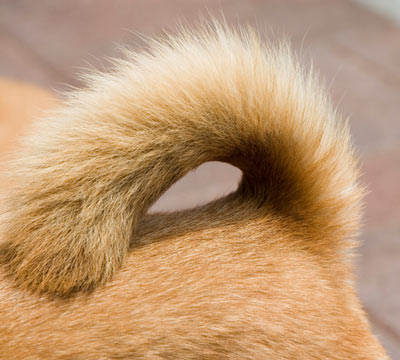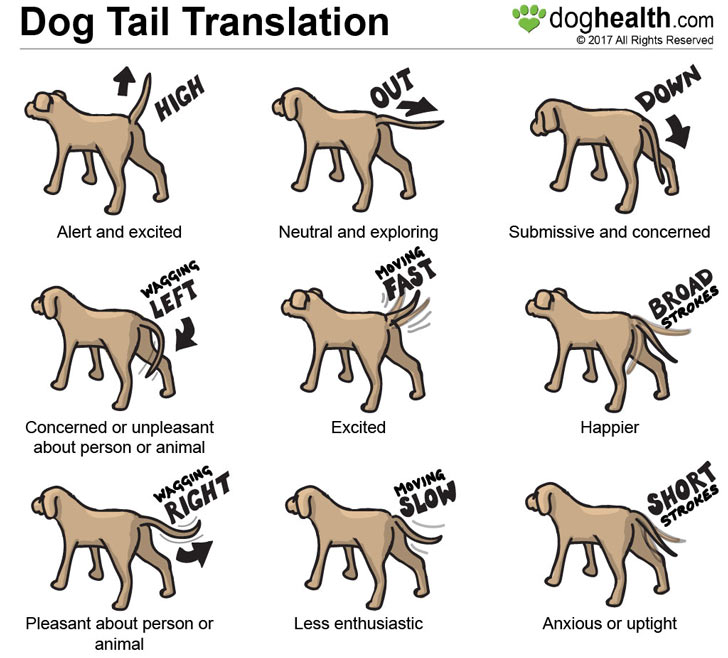What Your Dog's Tail Can Tell You

A dog's tail. It's one of the things that separates us from our canine friends, but it's one of their most endearing features.
Dogs' tails can communicate a lot of information to us if we know how to interpret it.
A Dog's Tail Position Has Meaning
The position of a dog's tail can communicate information about what that dog is thinking and feeling. Here are some examples:
- Tail held high and still indicates alertness and the desire to portray dominance.
- Tail held high and wagging shows happiness but also a state of alertness. The dog is cautiously excited but showing dominance.
- Tail held between the legs indicates fear or submission.
- Tail held straight out means that the dog is taking in new information and is so far responding neutrally.

Tail Wagging in Dogs Doesn't Always Mean Happiness
Tail wagging can mean many different things, and it must be interpreted along with a dog's other body language at the time.
Relaxed vs. tense facial muscles, upright vs. laid-back ear position, and whether the hair coat is standing up, bristling, or relaxed can all give information about a dog's feelings.
In general, dogs' tails wag faster as they get more excited, slower as they are less enthusiastic about something, have broader strokes as they are feeling happier, and smaller strokes as they're getting more uptight about something.
Even the direction in which a dog's tail is wagging means something. Researchers recently found differences in whether a dog's tail wagged to the left or right:
- Tail wagging to the right means a dog is feeling pleasant and is encountering something or someone known to him (Stanley Coren Ph.D., 2011).
- Tail wagging to the left means a dog is encountering a person or other dog that isn't known to him, and he wants to show dominance (Stanley Coren Ph.D., 2011).
Individual Dogs Have Differing Tail Communication
As with people, individual dogs can have their own habits with regards to their tail position and movement. You will get to know your dog's tail communication as you get to know him.
When you are approaching a new dog, it's best not to rely on tail position and movement alone to gauge his friendliness. Look at all of his body language together and also ask his owner whether he is generally friendly before you approach him. Learn more here: "How to Greet a New Dog."
Works Cited
- Stanley Coren Ph.D., F. (2011, Dec. 5). What a Dog's Tail Wags Really Mean: Some New Scientific Data. Retrieved from Psychology Today.
You May Also Like These Articles:
Use Your Voice and Body Language to Make Your Dog Happy
How to Avoid Expensive Veterinary Bills for Your Dog
10 Ways You Could Be Shortening Your Dog's Life - Slideshow
Dog Park Preparation Tips - Slideshow
Dr. Google: Helpful or Dangerous?
Is It OK to Let Your Dog Lick Your Face?
Disclaimer: This website is not intended to replace professional consultation, diagnosis, or treatment by a licensed veterinarian. If you require any veterinary related advice, contact your veterinarian promptly. Information at DogHealth.com is exclusively of a general reference nature. Do not disregard veterinary advice or delay treatment as a result of accessing information at this site. Just Answer is an external service not affiliated with DogHealth.com.
Notice: Ask-a-Vet is an affiliated service for those who wish to speak with a veterinary professional about their pet's specific condition. Initially, a bot will ask questions to determine the general nature of your concern. Then, you will be transferred to a human. There is a charge for the service if you choose to connect to a veterinarian. Ask-a-Vet is not manned by the staff or owners of DogHealth.com, and the advice given should not delay or replace a visit to your veterinarian.


